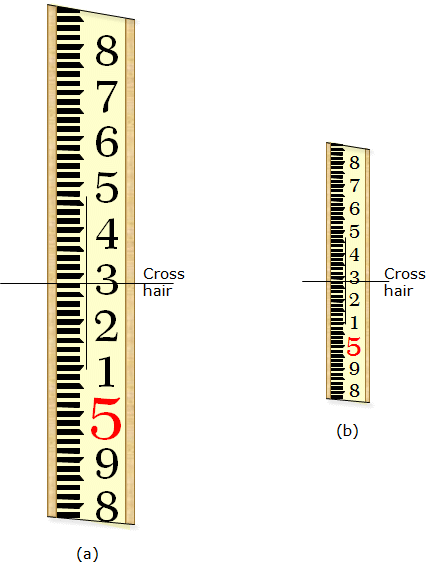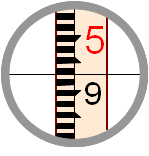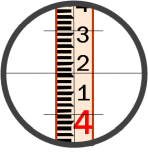3. Personal
a. Instrument set up
(1) Description
A stable correctly set up instrument is crucial for accurate leveling.
(2) Check
Anything that causes instrument instability or user discomfort will cause errors
(3) Behavior
The cumulative effect of an adverse, unstable, and uncomfortable setup situation is random.
(4) Compensation
Select a optimal location - dry, solid ground,; avoid asphalt. Setting up on or near roads can cause the compensator to "bounce" when vehicles go by; this can also happen on construction sites near heavy equipment.
Verify that legs are firmly seated, tripod hardware and legs are snug, instrument is at comfortable working height and correctly leveled.
b. Parallax
(1) Description
 |
| Figure D-15 Parallax |
(2) Check
Focus on an image. While sighting the image, move you head slightly. If parallax is present, the crosshairs will appear to move across the image.
(3) Behavior
Because the location of the operator's eye can change the amount the image and crosshairs shift with respect to each other can vary. This causes random errors in rod readings.
(4) Compensation
Follow the procedure described in I. Basic Principles Chapter E. Parallax should be checked and cleared every time the instrument operator changes.
c. Sight distance
(1) Description
Accurate rod readings are more difficult at longer sight distances. This is not only because the rod and its divisions become visually smaller, but also because the relative size of the crosshairs become larger on the rod. Figure D-16 shows the same rod and reading at two difference distances: the rod in (b) is twice as far away as the rod in (a).
 |
| Figure D-16 Same Reading at Different Distances |
In addition, wind and atmospheric anomaly errors along the line of sight increase at longer distances. All these conspire to introduce reading errors, and they can be substantial. Most manufacturers will specify a maximum working range for an instrument (check the manual) but consider this being for ideal conditions. Shorter sights may mean more setups but the trade off is more reliable readings.
(2) Behavior
The overall effect of longer sight errors is random.
(3) Compensation
Keep sights shorter.
d. Rod Use
(1) Description; Behaviors
Modern rods generally use a multi-part telescoping design. The first section may be 0 to 4 feet, the second 4 to 8, and a third 8 to 12. On some, it is easy to telescope the incorrect section resulting in a 8 foot tall rod which is graduated from 0 to 4 ft followed by a 8 to 12 ft section. Any reading above 4 ft on the rod would have a 4 ft error. Although this is a systematic error, consider it a mistake for not correctly extending the rod.
A traditional wooden Philadelphia rod is usually a two-section sliding design with each section approximately 7 ft long. When extending the rod, the rod person must be careful of two things:
1. To extend the rod all the way until it locks, and,
2. To face the correct side to the instrument. The bottom of the back side is blank, but the upper back side is numbered in decreasing fashion.
While systematic, incorrect rod use are mistakes.
(2) Compensation
Mistake reduction comes from experience. Practice, practice, practice.
e. Reading errors
(1) Descriptions; Behaviors
(a) Bad reading
The first time a surveyor reads a level rod can be confusing. A common mistake is a reading that is exactly one foot off. This happens when the sight through the telescope looks like Figure D-17.
 |
| Figure D-17 Reading Error |
The novice surveyor may concentrate on interpreting the hundredths and tenths, coming up with .93, and then subconsciously grab 5 for the foot reading because it's in the field of view. He'll report a reading of 5.93 when it should be 4.93.
If the distance is short, the foot number may not appear in the field of view. In that case, after obtaining the hundredths and tenths, the surveyor should tell the rod person to "raise for red." The rod person then raises the rod slowly and the instrument person reads the first red number which appears.
Most modern rods have small red foot numbers between the normal ones for these situations.
While a systematic error, it is very difficult to isolate and can be considered a mistake.
(b) Reading the wrong crosshairs
Most instrument telescopes have two stadia crosshairs equally spaced above and below the horizontal crosshair. These are used for horizontal distance determination as well as for precise Three-Wire Leveling. They are also used for LoS collimation which is discussed in Topic XV Chapter C Automatic Level.
A common mistake by a new surveyor is to read the level rod using one of the stadia hairs resulting in a reading that is either too high or too low, Figure D-18.
 |
| Figure D-18 Stadia Hairs |
Reading the wrong crosshair is a mistake.
(2) Compensation
Practice makes perfect.
f. Recording errors
(1) Description; Behaviors
Learning to compile field notes correctly can be confusing rife with errors for the beginning surveyor. Common problems include incorrect recording and running calculations.
It's important to compute EIs and point elevations as the data are collected and that a page check be done immediately at the completion of a page. Sometimes, a large rod reading mistake (see above) can be identified right away when the elevation is computed and checked visually. Running calculations are needed to determine closure at network completion and the page check helps identify and correct math errors.
These are mistakes.
(2) Compensation
Mistakes lessen as experience is gained. Some computation errors can be found and resolved performing a page check.